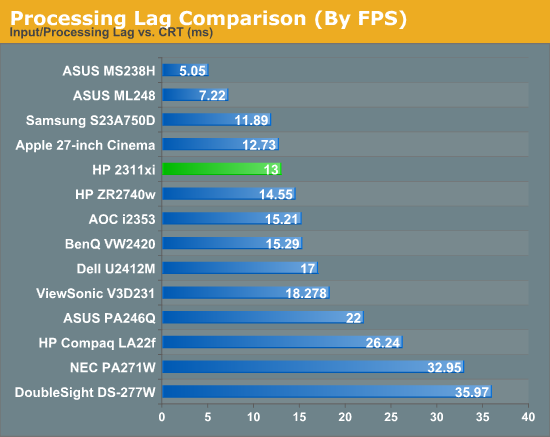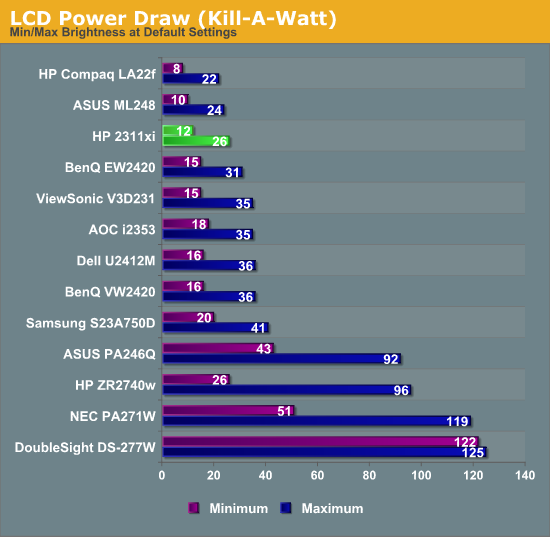HP 2311xi IPS Monitor
by Chris Heinonen on August 13, 2012 12:15 AM ESTHP 2311xi - Input Lag and Power Use
One area where the 2311xi does much better than its budget price would indicate is in our lag testing. Input lag ranged from 1-3ms on testing, showing very little delay at all. The response time from blue to yellow to blue was only around 20-22ms as well, giving us a total lag result of 13ms. This is a decent amount under 1 frame of lag and should be adequate for even demanding users, and this was with the Overdrive feature disabled. Overdrive being enabled made no noticeable difference with lag or delay time, but might help slightly with blurring. Overall these are some very impressive numbers for the gamers out there who might be considering using this panel.

Power use on the 2311xi was a high point as well. With the backlight at maximum it uses a miserly 26W of power, and that drops down to 12W at minimum levels. Finding a monitor that uses less power than this might be possible, but you will likely only save a watt or two over the HP. All the examples in our database that use less are either smaller panels, or TN panels instead of IPS. There is nothing I can complain about with the power usage of the HP 2311xi; it does fantastic here.












68 Comments
View All Comments
eallan - Monday, August 13, 2012 - link
So we're comparing full blow laptops with great specs to monitors now?darwinosx - Monday, August 13, 2012 - link
Yeah pretty odd comparison. Also Apple laptop displays have gotten great ratings on this very website.Sabresiberian - Monday, August 13, 2012 - link
So you can't figure out he's just saying that there are high density monitors on the market already, and is just using the Apple Retina display notebooks as an example?piroroadkill - Monday, August 13, 2012 - link
There are very high res TFT-LCDs. Check out the IBM T220/1, 3840×2400, 22.2", back in 2001...Just a very small market for them, or at least there is perceived to be a very small market.
gegiarmo - Monday, August 13, 2012 - link
Why do so many companies refuse to put Displayport in such nice monitors? Does it really cost that much more to add in?jeremyshaw - Monday, August 13, 2012 - link
I'm guessing, but maybe they reused an existing controller PCB to shave costs. Or an older controller ASIC without DP, that was cheaper.Bull Dog - Monday, August 13, 2012 - link
yea honestly I started reading the article and saw, 'with no DisplayPort input' and I felt like not continuing to read any further. No DP input, no chance of my buying it or recommending someone else to get it. DP is the future, get with the times.Bull Dog - Monday, August 13, 2012 - link
but after finishing reading this review it does appear to be a nice monitor for $200.My sister purchased a Dell U2312HM for $240 back when Dell had it on sale. She is quite happy with it and for the little extra $$ you get a much more adjustable stand, Display Port, VESA mounts and matte black plastic.
tk11 - Monday, August 13, 2012 - link
You said it... "DP is the future" but the now is still dominated by DVI / HDMI.Senpuu - Monday, August 13, 2012 - link
A quick wiki search reveals that the first monitor with a DP port was released in January of 2008. Over the intervening years, it's gained rather widespread adoption, to the point that every modern GPU has a DP port. DP provides the most connection bandwidth of any standard, it's adaptable, and it's royalty free to incorporate into your monitor design. It seems a little silly at this point to exclude it from a new product.I'd say that DP is the present...